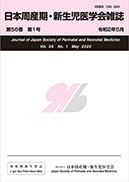Volume 57, Issue 2
Journal of Japan Society of Perinatal and Neonatal Medicine
Displaying 1-30 of 30 articles from this issue
- |<
- <
- 1
- >
- >|
Review
-
2021Volume 57Issue 2 Pages 234-242
Published: 2021
Released on J-STAGE: September 06, 2021
Download PDF (3176K)
General Remarks
-
2021Volume 57Issue 2 Pages 243-250
Published: 2021
Released on J-STAGE: September 06, 2021
Download PDF (2045K)
Originals
-
2021Volume 57Issue 2 Pages 251-256
Published: 2021
Released on J-STAGE: September 06, 2021
Download PDF (1320K) -
2021Volume 57Issue 2 Pages 257-262
Published: 2021
Released on J-STAGE: September 06, 2021
Download PDF (1409K) -
2021Volume 57Issue 2 Pages 263-268
Published: 2021
Released on J-STAGE: September 06, 2021
Download PDF (1527K) -
2021Volume 57Issue 2 Pages 269-274
Published: 2021
Released on J-STAGE: September 06, 2021
Download PDF (1479K) -
2021Volume 57Issue 2 Pages 275-281
Published: 2021
Released on J-STAGE: September 06, 2021
Download PDF (1595K) -
2021Volume 57Issue 2 Pages 282-287
Published: 2021
Released on J-STAGE: September 06, 2021
Download PDF (1398K) -
2021Volume 57Issue 2 Pages 288-294
Published: 2021
Released on J-STAGE: September 06, 2021
Download PDF (1967K) -
2021Volume 57Issue 2 Pages 295-300
Published: 2021
Released on J-STAGE: September 06, 2021
Download PDF (1476K) -
2021Volume 57Issue 2 Pages 301-308
Published: 2021
Released on J-STAGE: September 06, 2021
Download PDF (1430K) -
2021Volume 57Issue 2 Pages 309-314
Published: 2021
Released on J-STAGE: September 06, 2021
Download PDF (2051K) -
2021Volume 57Issue 2 Pages 315-320
Published: 2021
Released on J-STAGE: September 06, 2021
Download PDF (1863K) -
2021Volume 57Issue 2 Pages 321-325
Published: 2021
Released on J-STAGE: September 06, 2021
Download PDF (1597K) -
2021Volume 57Issue 2 Pages 326-333
Published: 2021
Released on J-STAGE: September 06, 2021
Download PDF (1825K) -
2021Volume 57Issue 2 Pages 334-338
Published: 2021
Released on J-STAGE: September 06, 2021
Download PDF (1587K) -
2021Volume 57Issue 2 Pages 339-342
Published: 2021
Released on J-STAGE: September 06, 2021
Download PDF (1320K)
Case reports
-
2021Volume 57Issue 2 Pages 343-347
Published: 2021
Released on J-STAGE: September 06, 2021
Download PDF (2227K) -
2021Volume 57Issue 2 Pages 348-352
Published: 2021
Released on J-STAGE: September 06, 2021
Download PDF (2031K) -
2021Volume 57Issue 2 Pages 353-359
Published: 2021
Released on J-STAGE: September 06, 2021
Download PDF (2290K) -
2021Volume 57Issue 2 Pages 360-365
Published: 2021
Released on J-STAGE: September 06, 2021
Download PDF (1712K) -
2021Volume 57Issue 2 Pages 366-370
Published: 2021
Released on J-STAGE: September 06, 2021
Download PDF (1893K) -
2021Volume 57Issue 2 Pages 371-375
Published: 2021
Released on J-STAGE: September 06, 2021
Download PDF (1935K) -
2021Volume 57Issue 2 Pages 376-380
Published: 2021
Released on J-STAGE: September 06, 2021
Download PDF (1658K) -
2021Volume 57Issue 2 Pages 381-384
Published: 2021
Released on J-STAGE: September 06, 2021
Download PDF (1812K) -
2021Volume 57Issue 2 Pages 385-389
Published: 2021
Released on J-STAGE: September 06, 2021
Download PDF (1626K) -
2021Volume 57Issue 2 Pages 390-394
Published: 2021
Released on J-STAGE: September 06, 2021
Download PDF (1286K) -
2021Volume 57Issue 2 Pages 395-398
Published: 2021
Released on J-STAGE: September 06, 2021
Download PDF (2012K) -
2021Volume 57Issue 2 Pages 399-403
Published: 2021
Released on J-STAGE: September 06, 2021
Download PDF (2491K) -
2021Volume 57Issue 2 Pages 404-408
Published: 2021
Released on J-STAGE: September 06, 2021
Download PDF (1870K)
- |<
- <
- 1
- >
- >|
